We have reserved an area of approx 3/4 ac within our pondsite footprint as a shallower wetland zone. About 75% of this zone is open water. The balance is an area where we did not clear the timber all the way back to the normal pool shoreline. This way, the water will back up into the trees varying horizontal distances. I am guessing the water will go an average 40 ft. back along about 175 ft of shoreline, likely killing most of the timber it covers. I assume some trees will fall out into the balance of the cleared wetland zone...good! That's the plan.
-
-
OK, here's the question to my PB comrades.
Remember, this a wildlife refuge/nature preserve. I want to enhance this zone to promote exactly that. My first plan is to place Wood Duck houses on poles; maybe 4. What else?
How deep will it be? Do not place the nesting boxes facing each other. Nesting rates really fall off if the hens can see each other. If you are patient, mother nature will take care of adding habitat. Suspended seeds in the soil will sprout and come up as proper environment will allow. Depending on the water depth and seasonal fluctuations will determine what plants grow.
I like bat houses, we have built a few and had them hibernate over winter. It's neat watching them in the summer at dusk as they exit in swarms. I have easy to follow plans if anyone is interested.
h2Ofwlkllr,
I knew I could count on you, although YOUR ultimate goal with critters would likely be different than mine.

The area in the timber will run from 0 to 2 feet. Then the open water will take over at 2' to 5 ' on a fairly gradual slope over about another 150' into the open water zone. I realize that the 5' is probably a bit beyond correct classification as wetland, but that's how it turned out. I expect I will have decent natural growth in the first 3 - 4 feet of water depth...? Should I sow anything in the soil before the water arrives (which may be many months)?
Wood,
Yes, I am interested in the bat thing, but I am concerned if it will interfere with the other natural habitat stuff I want to see develop.
I built a bat house and read everything I could find. The bats just don't read from the same books that I have.
If you want to speed up animal usage and limit erosion, plant some japaneze millet. Now is also a good time to collect seed pods from arrowhead. It attracts many forms of wetland creatures. The MDC website has many pdf files on creating wetlands and attracting wildlife. very good reading.http://www.mdc.mo.gov/landown/
Every National Wildlife Refuge that I've been to has islands for the ducks. I was told that they are safer from preditors when surrounded by water. This is especialy important for nesting. Do ducks nest in your area?
Not all ducks like timber, in fact, allot of them perfer open water. You could plant some areas for them along your shorline. They seem to like to dig out the plants from underwater quite a bit too.
Windbreaks and shade seem to be spots I see them during the day. My pet ducks spend all day sitting under my dock, while the goos stands on top of it.
Ducks love floating catfish food!!!!!
Get some live Rouen ducks. They look just like mallards, except they are too big to fly. They will get used to you and hang out around your. My goose follows me around the yard sometimes and he's wild. He will fly after the herons sometimes, but always comes back.
Live ducks swimming around will atract wild ducks. It's VERY illegal to hunt over live ducks, but since that's not your goal, than they will work great for bringing visitors in.
Eddie

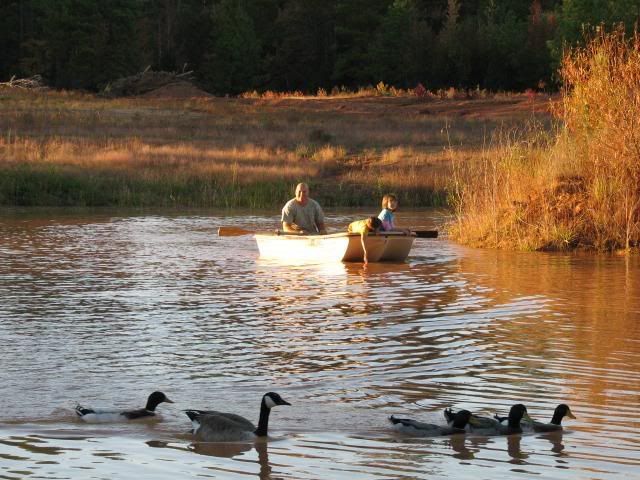
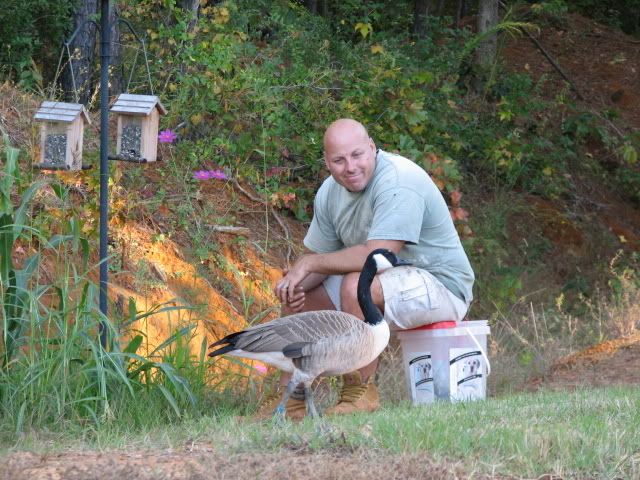
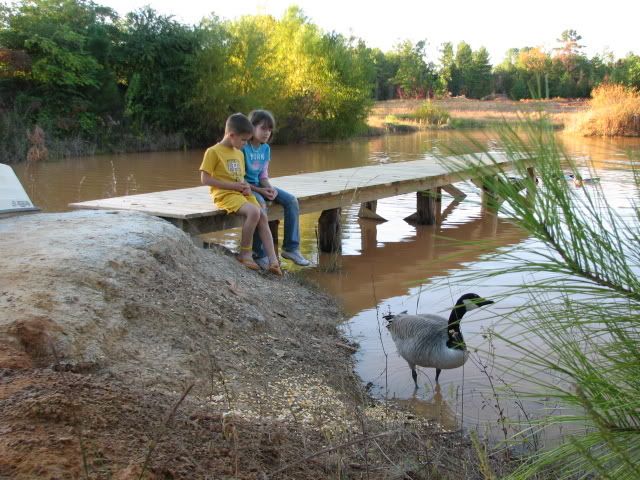
Very nice photos Eddie! That second picture is an award winner in my book. However something is wrong but I just can't quite figure it out.
Oh yeah, now I see it. After reading all your posts, I just can't picture you sitting down and taking it easy. Isn't there a motor around that needs rebuilding, a dirt pile that needs moving or a backhoe job that needs attention?

Brettski, the first thing to remember that there is no such thing as "wildlife". This perhaps the biggest mistake wildlife managers make. There are only different species and ecosystems. When we manage an area for "wildlife", it really is just for different species and ecosystems.
Most wildlife managers will tell you that you need "edge" or areas where two types of cover meet. The whole county is "edge"! "Edge" species are the winners in our society. The great loosers are the species that need solid areas of habitat such as mature forest or grasslands.
All that being said, most of us want the types of species that come with edge.
I would get the book "Wetland Plants and Plant Communities of Minnesota and Wisconsin by the US Army Corps of Engineers. It should apply to your area.
There are professional societies devoted to wetland restoration. Here are some ideas from them.
"Weeds" or undesireable plants are your biggest problem. One of the very worst is reed canary grass. I would kill it any place you see it. You will probably have to keep at it for many years. I've been killing it for 5 years now on our 50 acres of CRP and still find clumps of it all the time.
Next, the most agressive plants will colonize your area the fastest. It's sort of the firstest with the mostest win. So you want to plant the species you want so that they are established and hard to push out by more agressive species. One thing to remember is that a species that might be horrible in one area might be great in your area.
Wetlands are first known by their plants.
Now to animals. We have 20 wood duck houses up. One thing to remember is they don't have to be by water. Wood ducks often nest 1/2 mile from water. Bats are a free insect control.
Marvin Maberry is a retired Oklahoma highway patrolman and makes the best bat houses by far.
maberrybat.com Bluebirds and purple martins are other common choices.
In our 4-acre lake, we have 7 islands. The advantage of islands is that they keep out cats, possums, skunks, dogs, foxes etc. Raccoons and mink can still hunt them but at least the number of predators is decreased dramatically.
We have 5 wetlands ranging from 1/2 acre to 5 acres, all with their own personalities. In them, we have everything from snipe to wood ducks and one restored sedge meadow. It's all great fun to watch and work with.
These are some general ideas. If you'd like more specific information, I'd be glad to try and help.
Well, I'm done with my Christmas shopping! Boy, will Donna-ski be surprised! In a way, I hope this will be the gift that keeps giving.
-
-
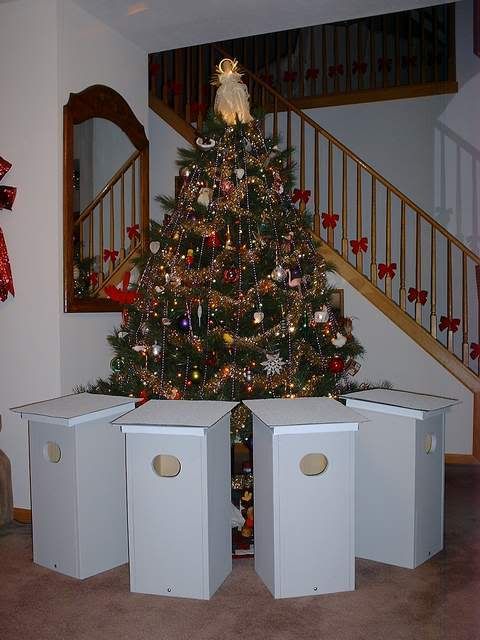
-
-
4 Wood Duck boxes, ready to mount. There are a bunch of plans for these things on the www, but I opted to work with the basic dimensions and details from the
LSU Ag Center plans . The
Wood Duck Society is another great site for info. Each unit used 1 pc of 1" x 12" x 120" lumber. I started with the idea to use cedar, recovered from sticker shock, and drifted down to the pine rack and used some exterior primer and light gray exterior stain I had in stock. I painted the entire roof, also. Then, some aluminum drip edge, a hunk of white roll roofing attached with dabs of polyurethane roof caulk-adhesive, and the next stop is the pondsite.
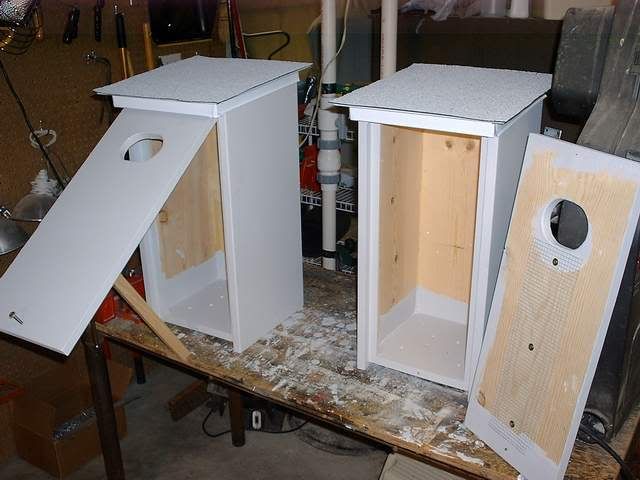
-
The front panel is hinged right to the overhang of the roof panel. I learned some real helpful tips from Myron the Wood Duck guy, an extremely helpful guy I met online while googling Wood Duck stuff. One thing that is not a mystery is the absolutely, most critical item on the materials list. A section of 1/4" galvanized hardware cloth
firmly attached to the interior of the box, running from the bottom of the box up to the entry/exit hole. This is necessary to allow the ducklings the ability to climb up and out of the box, often the next day or two after they hatch. If there are any malfunctions with this simple duck ladder, it becomes a death trap. Then Myron adds his tip to tilt the boxes when mounting and installing, top forward, to allow a slight angle of about 2" off plumb to assure the ducklings can make it out. Strangely, if and when they hatch and make it out, they won't return for the balance of the year. They literally jump out and head for the nearest wetland area to develop. We hope they find our zone a welcome home.
The location of the houses and their mounting poles are planned to be about 20 or 30 feet out from the flooded timberline. When I asked him about cluster or orientation, Myron notes:
People have set up three in a row—that would be ok but no more than 3 in a row. I was told they can decipher left and right and middle but any more than that and they can’t decipher where they were.
He strongly warns against installation on a tree or similar due to the ease of predation. We will definitely engineer a predator guard on the pole. I asked Myron if I should even bother hurrying up and installing them this winter, or wait until spring (assuming the water level won't be that high yet). He said to install them right away. It is not unusual for other birds to use them as safe haven during the winter. He lives in a northern climate and said he went to clean out one of his many boxes in December. He opened one and got this surprise.
-
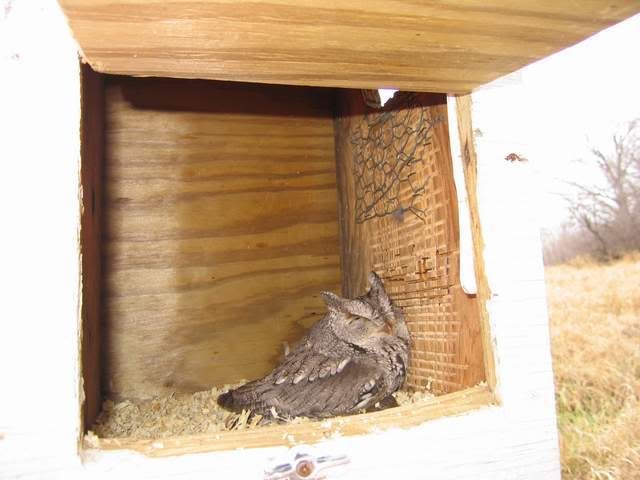
-
Myron explains:
Attached is a pic of an Eastern Screech Owl I came across when I was cleaning out WD nest boxes in Dec 2004. It startled the heck out of me because this was only the second time I came across a critter in the box at this time of the year. The first time I was startled even worse when I started to open the door on a box [that some else had installed in a tree] and a mink came out of it frantically fast. I thought I was going to get bitten.
I asked him to further describe the owl encounter, particularly as to how he managed a picture:
Once I heard the noise in the box and saw the critter I slowly and quietly closed the door. Then I pulled out my Cannon Power Shot S60 and slowly opened the door and took one or two photos and quietly closed the door. Yes, the owl was in the middle of a day-time deep sleep. It looked like a human getting woke up at 03:00—it couldn’t hardly open its eyes and it also was startled. What a little cutie ha?
So, we will see how the weather holds up and if Donna-ski is up for some Christmas present installation.
Hey Brettski,
I'm suprised at the size of the boxes. I have never built any myself, but I've seen them all over the California Delta and Marsh areas. It's been quite a few years, but I thought they were about half the size of yours. I'm gonna read up on the links you provided, but can you explain in more detail why you chose your materials and sizes?
Why pine over plywood?
Do the birds land at the hole? I don't get how they get into the box. It could be that I'm thinking bird houses for song birds and have a mental block.
I have a creek along my boundry that is full of wood ducks. We kick up a pair or two pair all winter long every couple of hundred feet while walking along the creek. I'd love to put some boxes out and have even more of them!!!!
Bat boxes too. Are you going to build any of them? I have small brown bats around my small pond all the time and it's fun to watch them feed. I've read that they are great at eating allot of mesquitos, so the more bats I can have, the more they will eat!!!!!
Thanks,
Eddie
Hey Eddie,
The WD boxes I built from the LSU plans are 24" tall overall. Most of the plans I encountered were similar. I used the full 11.250" width of the 1 x 12" pine boards on the sides. This was one of the reasons I selected 1 x 12 pine. Easy handling, minimal cutting. Oh yeah; it was on sale. When I was a kid, I got interested in and involved with furniture quality woodworking. This, and my perfectionist attitude, contribute to my overkill habit. These nesting boxes follow suit. If you look at Myron's boxes, the pic with the owl, it's plywood. You could make them out of OSB if you wanted to; the animal won't care. There is one consideration that I did discover. They weigh alot. If it was correctly dried cedar, it would be alot lighter. This combined with the longevity of cedar makes me wonder "after the fact" if I should have just paid the extra for the cedar and been done with it. Oh well, I have also been known to spend a buck to save 50 cents.
To me, at this point in my life, I endeavor to build things correctly with the low/no maintainence objective. I am hoping that the time I spent constructing and finishing these nesting boxes will last a good 10 - 15 years, requiring only nest cleanout.
So, back to the construction. I used polyurethane glue (Gorilla glue) and put the pneumatic finish nail gun to work with 2.5" x 15 ga. galv finish nails.
I have never witnessed a wood duck entering a nesting box, but one of my neighbors has them and he says that it is borderline comical. He says that they fly nearly full speed directly into the hole. I gotta see this one. (maybe Norm or some of the PB'ers can fill us in).
Right now I am working on a batch of wren/chickadee houses. The bat houses are on the radar (or is that sonar?) I read in more than one place that they consume upwards of 1000 mosquitoes per night. Blue bird houses are comin' soon, too. I am going to go with the Peterson design. Mallard nesting tubes are also on the list.
I built a WD nest last year that resemble yours Ski. I have had Whistling Ducks in there the last 2 springs. It is comical to watch them get in the hole. They do fly right at the hole then grab the hole with their webbed feet and pull themselves in head-first. I did shoot a 64" mocassin out of the house the first spring. I think it was egg hunting.
Ski, I have built both bat houses and bluebird houses.
So far, I have never had a bat take up residence.
However, I did successfully get blue birds to nest. I was thrilled. Then, the squirrels successfully wrecked the nests and got the eggs. I tried building excluders but I couldn't get them tight enough around the T posts. So, I kinda bent it down and hung it like a pup tent so the tree rats couldn't get above it. That worked. However, they flap in the wind and now not even a self respecting sparrow will use them. I hope your luck (or skill) is better than mine.
Brettski, I recognize that your nesting box is much better than mine because the entire front of yours opens for cleaning, allowing a much more thorough job. I will definitely use your design in building my next boxes but will use a hook and eye (maybe two) for securing the front panel instead of a screw.
Some people claim that the use of a one inch pipe for a mounting pole will exclude predators, but my boxes are mounted on treated 4x4 posts with a shield below the box. If your boxes will be placed in a wooded area that would allow predators to jump from adjacent trees onto the box, you might want to consider a shield above the box as well as one below. When deciding which box they like best, the ducks sometimes perch on top the box, so the upper shield should be high enough above the box, and the roof surface rough enough to allow that.
Don't forget that wasps like to build their nests under the shields.
Don't be at all concerned about the ducks being unable to get into the box through that little hole (and without a perch!) They nail it cleanly every time.
Yo, Dudley...
I am still wrestling with the mounting pole, but am leaning toward use of treated 4 x 4's. What type of predator guard are you using on the pole? I have used the circular sheet metal cones with good results on smaller bird feeders. My reading on WD nesting boxes reveals use of a 36" dia. min. sheet metal cone. Dang, that's huge!. Not only is it big and gawdy, it's probably a real shaker and hummer in the wind (wintness DD1's post on page 1).
I am now thinking about the 12" dia x 48" galv. stove pipe with a cap at the top. Have you seen these? I wonder if it would still stop a coon? IIRC, the correct installation allows the pipe to rock freely on the pole, supported under the cap at the top by large spikes.

I wonder if it would bang around and make a bunch of noise in the wind?
I think the design of your nest takes care of most predators. Coons & possums can't reach the eggs or enter the nest. Just probably snakes...
** Wood Duck box update **
Subsequent to a few questions that Eddie asked on a previous post, I have some fundamental input from Myron the wood duck guy. For the record, I had already constructed the basic boxes before I met him. Nothing catastrophic, but I would likely change a few things. I emailed him the same pics I posted on this thread with the construction details. Here are the updates and details.
a) My box design is larger, but will work just fine. He elaborates:
The old style 12 x 12 is like a dance hall. The larger size encourages multiple hens to use it at one time. By the way the hen has to turn all the eggs at some sequence so it makes it physically impossible when there is more than say 15 eggs

He recommends use of the details given on the
WD Society PDF plans link (this may help answer Eddie's query WRT size; the primary diff from my boxes is a smaller width and depth).
-
-
He also noted a very critical potential for disaster on my boxes. I told him the details of the duckling ladder I installed (see the pics on previous page).
I mounted the 4 1/2" x length hardware cloth (1/4" squares) with 3 brass flathead screws with larger stainless steel washers to help pinch the mesh down. I closely trimmed the edges of the hardware cloth to minimize sharp wires, particularly at the top where it is next to the entry/exit hole.
...his response:
Other Critique Observations: Good observation on the sharp edges—yes it does matter. I wouldn’t want the hens webbed feet to get ripped. What I do is fold in the top and sides by about 1/4" - 1/2” and then screw it on. Be sure to install a washer & screw at the extreme upper left and right corners—yes it does matter because the adult hen will pull/ fold it down [the way it is now] and essentially make a death trap for the ducklings. The way you have it is a common mistake. You could just install some add’l screws to the outside edges. I have used 1/2" staples in the past and I don’t recommend it.
I asked his opinion on predator guards:
I am torn between the gawdy sheetmetal flattened cone design...or...the 12" dia. stove pipe design. Any thoughts about the stove pipe?
He replies:
The worst predator is the raccoon. I believe a raccoon could crawl up a 12 inch stove pipe. What they do is bear-hug-crawl-up. Even a stove pipe would not be a significant deterrent/ barrier—unless it’s around 18”+ in diameter. That’s why I sent you additional predator guard photos for add’l ideas. If you use the light gauge aluminum roof flashing sheet-metal [and the 12 x12 box is more applicable to using sheet-metal] you need to flare it out like an inverted funnel. Sheet metal installed straight down is not enough to stop a raccoon and I have close up photos illustrating this by scratch marks on the outside of the box walls. No matter what you go with, think about how raccoons [& I’ve observed it] can literally run up and down a tree just like a monkey.
-
To clarify his practice with sheet metal, he will take tin or aluminum sheeting and screw it to the bottom of the wooden box structure, around the entire perimeter and pointing downward to create a barrier.
Brettski,
Wouldn't the predators be able to gain access through the open top where the photo was taken?
P.S. The coons aren't supposed to be able to get in the correct-sized oval opening.
Hey BarO...
I think the photo with the eggs was taken of a unit with a removeable top. It appears to be a design with no access from the 4 sides.
The correct WD opening is 3" tall x 4" wide. I cut mine with two 3" dia holes, staggered off center horizontally by 1 inch. I find later that the ideal hole is more "football" shaped. I have seen both types, but the football seems more prevalent. I asked Myron if I had made a fatal mistake and he replied "absolutely not...go with it".
I have a set of drawings for numerous different types of critter nesting boxes. One page has the various hole sizes/shapes. The raccoon hole is 5" hi x 6" wide (for the record, it is the same hole for a Common Merganser). I don't know enough about raccoons to be able to say if they could squeeze thru a 3" x 4" hole....or how far they could reach in...?
Brettski,
I'm trying to figure out a way to mount those boxes to trees. I just hate the idea of putting them on poles for a visual reason. It's just me, so please don't think I'm critisizing. I want the boxes and I want them on the sides of trees.
In the Sacramento River Delta of California, they are very common all over the place in trees. Some have Fish and Game info on them, others are just put up by duck hunters. I think the duck hunters put up more boxes than any other group, but I can't support that. It's just an opinion.
If a box was put on a tree, how would a racoon gain access?
I'm assuming it would be from the roof of the box. He'd climb over it and reach into the hole from above.
Would a steep pitch and a slipery material like tin be a good deterent? If they slide off the roof, will they be able to get inside the box?
They must have something to grip onto in order to climb. If the box was smooth all around the sides, then they shouldn't be able to get around the box either.
OSB with the resin side out should be smooth enough to be unclimbable? What about painting it too? Make is as slick as possible.
Thanks,
Eddie
I am only working with I read and what Myron has been offering, but trees are a no-no. Any critter that can get thru a 3" x 4" hole will have breakfast. One of my above posts pointed out mink as a popular offendor. I think you will hard pressed to provide enough predator protection on a tree to provide safe haven. I won't do it. I cannot encourage nesting to provide a neighborhood buffet.
Brettski,
I agree that the whole point of putting up the boxes is to increase the bird population and not to feed the racoons.
I mention the boxes I've seen as an example of what allot of people there are doing. The boxes are very common now and seem to be all over the place. It could be that I never looked before, but when I did start looking, I saw them.
Now that I'm in Texas, I don't have access to good duck hunting like I did there, so it's not been a priority. But I'd love to do what I can to improve the habitat and have more wood ducks.
Currently they are in my creek and we can see them flying up and down the creek late in the evening. They must be nesting in the trees someplace, but who knows how many eggs are lost to predation?
I'm looking forward to see how your boxes look when you mount them. Maybe I'll change my mind about the poles.
Thanks,
Eddie
Hey, here's a thought about you noticing the number of these boxes and their sizes. I noted above that I have this printout of a bunch of critter nesting boxes. For the most part, they are ALL shaped the same. The only variable is their outside dimensions and the hole size/shape. The raccoon box...same shape. Even the pileated woodpecker box looks similar; just smaller.
I went back and rechecked Brettski's photos of his Wood Duck boxes and saw that the fronts are secured by screws when closed. That's good; I don't think raccoons have learned to work screwdrivers yet. They can operate many types of latches.
Sorry Brettski......I was trying to be humorous. Ouch!
don't be sorry, BarO...allow the clown to bow.

(next time, gimme a firm signal with the roll-eyes....the graemlins were invented for guys like me)

There's not a problem I can see that's not been already mentioned. My openings were rough cut with a jig saw, and a 4" grinder to open them up a bit. 3x4"? yeah, something like that...
I made mine out of some 10" wide old cypress boards that were laying in the barn for about a hundred years. They'll probably outlast me.
For cleaning, I hinged the bottom (it fits inside the sides) and drilled oversize holes through the front, into the bottom. Shoved in 16d duplex (double head) nails. I don't need any tools to open them for cleaning...pull the nail, bottom drops open.
I'm not sure what to call the things I mounted them on...they're steel, sorta u-shaped, heavier than a T-post. They're used as diagonal braces between wooden fence posts. Several leaning in a corner of the barn. Before I drove them in the ground (with the bucket on the 560, as I'm lazy) I slipped a piece of 4" schedule 40 pvc over the "posts". Ain't seen nothing able to "hug" that stuff and climb it, yet. And, I've got plenty of coons, snakes and a few mink running around.
If you're like me, you may have WD's nest/hatch, and yet never see them. Two years now, they've successfully hatched (IDNR biologist explained the difference in shell pieces between hatched and eaten nestlings) but I've never seen the babies. I believe they immediately lead them to the neighbor's pond, as it's 1/4 mile from anybody...
No problem, Ski.

Hey Bar-O and the rest of you raccoon experts. First of all, does it make sense that I have plans for a raccoon nesting box with an entrance/exit hole that is 5" hi x 6" wide? (don't worry, I don't plan on using them) I look at the hole pattern on the paper, measure it to be sure, and still cannot believe that a coon can skamper in and out of that small of a hole.

Then, I put it next to the WD hole pattern that is 3" hi x 4" wide and think to myself "well, if it was a youngster or anorexic coon, maybe he could squeeze at least his head and couple of coon-arms in there.

Now...the big question: are they coon-arms or front legs? :rolleyes: (how's that for Graemlin-ese?)
Based on my experience with "city raccoons" if they can get their head in, they can get in. I gotta say arms and hands up front, they would reach in the pond, pick up snails and eat them as daintily as you please.
I think pert near all coons could get through a hole 5"x6", least wise all but the great big'uns.
P.S. They's got paws on 'em, so they muss be front legs.
My WD nest extends about 20" deeper from the bottom of the 3"high X 4"wide opening. It would take some Long-Front-Legged coons to reach the eggs or ducklings(maybe a reverse/kangaroo mutation).
Originally, the WD nest was attached to a young pine tree at the very top reach of my front-end loader on the tractor. It was probably close to 18' up 5 years ago. In other words, the nesting birds have to do spring cleanup themselves....
Another reason to put on a free standing pole.
On the bright side, the returning ducks get a new view from a higher perspective every year.
Matt,
Just curious, what is the difference between hatched eggs and eaten. I would speculate that the hatched eggs end up in two pieces while critter eaten ones are crumbled to pieces.
If they're like chickens and quail, Russ, I'd expect you're essentially right - hatched = big pieces with a smaller section chipped out vs. eaten = miscellaneously crumbled up.
Brettski,
I've been reading up on boxes and had a few questions. Did you consider cutting grooves into your board with the entrance over wire? I don't know anything about either aproach, so I'm curious if you did any research on it.
I read that wood ducks don't build there own nests or carry any nest materials. It said you need to put wood shavings in there, not sawdust. Are you gonna do that? Where do you buy wood shavings?
Wasps can be controled with a no pest strip. What's that? I'll look around, but have you heard this? Is one brand better than another? Any recomendations?
From the two dozen sites I went to, the dimensions all seem about the same. I have an idea to build one just a little different with some materials I have on hand, but I'm still researching.
When are you putting yours up? They said cleaning time is December and January, so I'm assuming we have lots of time.
Thanks,
Eddie
Eddie-man,
Yep, the cross cuts in the face of the board is a good idea, but I passed on it thinking that the hardware cloth would provide a higher level of duckling traction. Also, this area is below the only opening in the box where rain could be blown in...so...Mr. Overkill considers that water could collect in these grooves, particularly since the boxes will be leaned forward slightly. This might promote early decay because I used pine. Nope, I also passed on any finish on the interior to maintain a natural, chemical-free wood environment. The only place I put interior finish was on the bottom panel and about 2" up the sides because any water that does enter, whether it be thru the hole or because some duck forgot to wipe his feet, will eventually migrate to the bottom. I also drilled 8 holes x 5/16" dia in the bottom for drainage. I am not concerned with compromising the au-naturale interior by sealing the bottom because....
I plan on laying a bed of 3" - 4" of cedar shavings. We picked up a 16 litre bag of Kaytee Cedar Bedding and Litter (pure cedar shavings) from PetsMart. I think it cost about $7. It will be plenty for a couple/three years.
A no-pest strip. How old are you? These things first came out in the late 60's, manufactured by Shell Oil. They were famous: "the Shell No-pest strip". Honestly, I don't know where to buy them, but I presume there are plenty of knock-offs. It looks like a strip of cheese, about 1/4" thick x 2-1/2" wide x 12" long. Insects are attracted to it and if they touch it; dead.
Lastly, I recommend you follow Myron's directive to use the dimensions shown on the WD Society link I provided in an earlier post.
Brettski, The latest pest strips I bought were at a feed store. I think most of them carry it.
They're also available at the Conehead Deli.
...funny you ask, Mr Walker:
When are you putting yours up? They said cleaning time is December and January, so I'm assuming we have lots of time.
Oy, I'm gettin' too old for this stuff...
The area slated for the WD boxes and other nesting structures is the small, shallower wetland zone between the beach and the building pad.
Because I elected to use pine instead of the lighter wood, cedar, my WD boxes are on the heavy side. I just cannot see them enduring long term on a metal pole pounded into the ground. We elected to use treated 4 x 4's.
I rented the one man ground hog unit, the same one on wheels that we used for all the concrete piers at the docks. We drilled eight holes, 8" dia, spaced out along the (someday to be flooded) timber line, about 20' out from the trees. Each hole ran about 30" deep. We sakrete'd 8 base poles in. I set the tops of these base poles at 24" above normal pool.
Then, I pre-fab'd the top poles in the comfort of the basement workshop. Each top pole is another 4 x 4 x 48". 4 poles will receive the WD boxes and 4 will remain empty for future development. The 4 poles that receive WD boxes also have tilt boards attached at the top. This will tilt the WD boxes forward, about 3" off plumb. These tilt boards were fab'd from a 22" long section of treated 2 x 4. I ripped the 2 x 4 across the diagonal creating 2 mirror image wedges x 22" long. They were screwed to the 4 x 4 top pole with SS screws, leaving a 1/2" gap between them. The 2 SS 3/8" x 10" carriage bolts that attach the WD boxes to the poles feed right between these tilt boards, in the 1/2" space. The box mounting carriage bolts continue thru the 4 x 4 top pole, SS washer & nut at the back.

-
-
The bottom pole is permanently embedded in the concrete. The top pole is designed to hinge, allowing access to the nest boxes by removing one 3/8" x 10" SS bolt.
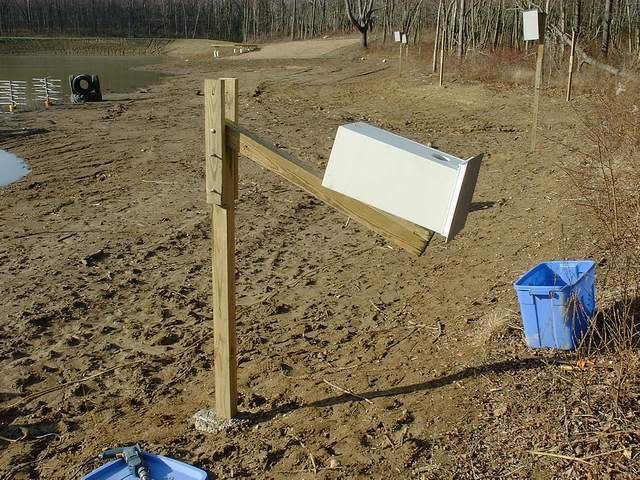
-
-
The hinge assembly is basic. It is a coupling of 2 pc of treated 2 x 4 x 24" long. The bottom pole is securely thru bolted with 2 pc 3/8" x 10" SS carriage bolts/washers/nuts. The top pole has a mirror image of hardware, but I made the very top hole 1/2" dia to ease removal of the SS bolt.
I provided a 1/2" gap between poles. I also cut 45 degree chamfers on the top pole. Each of the two chamfer cuts eases 1/3 of the width of the 4 x 4. The center 1/3 remains square with the pole. This allows the pole to swing down, unemcumbered.
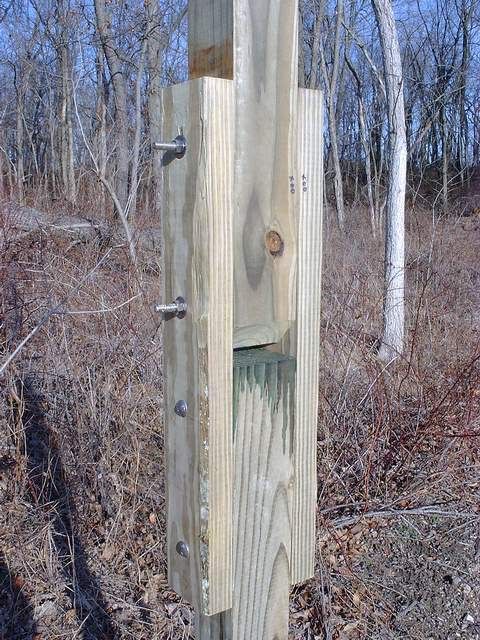
-
-
We have 8 poles totally installed. 4 of them have the completed WD boxes installed. I still have to design and install predator guards; fill ya in when we get there. I already know that one of the other 4 poles will support a bat house, so that leaves 3 for additional fowl thoughts.

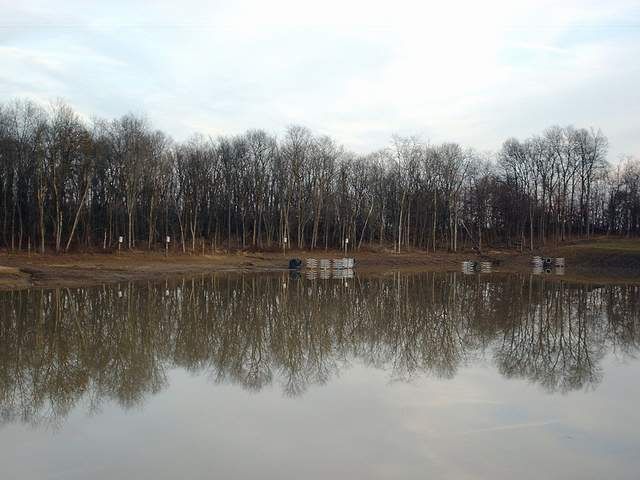
Oh yeah....and a few more nesting boxes.
I knocked out 8 pine boxes with 1-1/8" holes, suitable for wrens and chickadees, but small enough to exclude sparrows. These got screwed to trees just off of the walking trails in the vicinity of the pond. Bathouse is next.
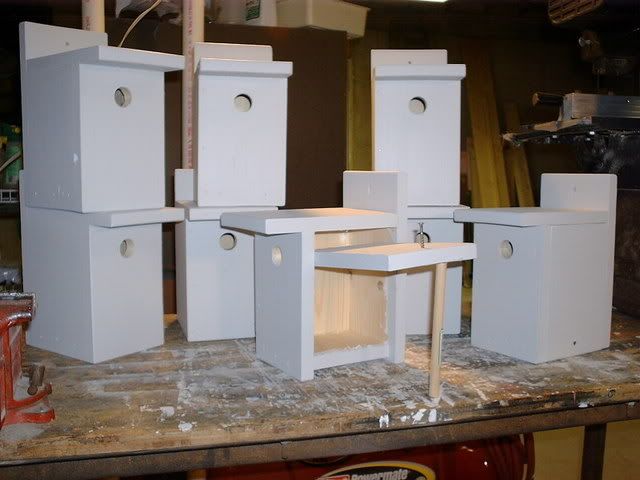
Originally posted by Brettski:
Bathouse is next.
Are you moving in permenently or just visiting? :rolleyes:
I've never seen a bathouse, Brettski (at least one for actual bats). That should be interesting.
Is the access hole in a no-sparrow birdhouse still supposed to be the size of a quarter?
Bathouses are very difficult to construct, particularly the required batpole. When installed correctly, they will also attract robins and occassionally penguins.
-
-
-
-
-
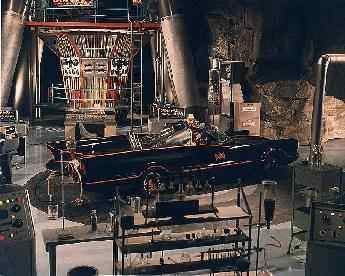
Ouch! And hopefully a feline.

B-ski,
Stop it, your kill-in me!!


Theo and Russ:
You're pretty close...the shells of "hatched" eggs basically show a round cap sorta pecked off the fat end, with the rest of the shell more or less intact. Lil 'uns use that egg tooth to do this...
If the nest has been raided, the shells would be pretty much hacked to pieces...no pattern at all.
BTW...cleaned out the box on the pond and it had an old nest in it...success. Did the one on the creek and it had a huge squirrel nest jammed inside...oh well. However, I was a bit leery of dumping that out. Figured I'd catch a pile of pissed off tree rat, but it was unoccupied at the time. Used chain saw to clear limbs about 5 feet away from that one. Hopefully, Mr. squirrel sees it's just too much work to get back in that one...we'll see.
Glad you didn't utter the ultimate panic cry: "SQUIRREL!"
Did someone scream " TREE RAT ". I am surprised that your box was not gnawed to pieces .

Matt,
Won't the squirrel have no problem climbing the channel posts you use to support the boxes?
I'm a new member as of today, what a great site! I just wanted to comment on the Wooduck house information as I have "been there and done that". If you place your houses on trees you will learn the hard way that its a mistake. By "hard way" let me share what I mean. Nothing gets you from the top of a ladder to the bottom faster then opening a wooduck house with a coon in it! "been there done that" saved ware and tear on the ladder steps as I didn't use them goin down!


That tree had one of my "sure fire" coon stoppers on it which was to wrap the tree with sheet aluminum. Closer observation revealed the muddy paw prints some how going up! What I have now for all my houses is a 10 foot 2" dia. galvinized pipe pounded in the mud over water. Then I put a 4 foot piece of a 2 1/2" pvc pipe over that under the house. The pvc rest on another small piece of pvc that gets bolted to the pipe. This way the pvc spins on the pipe so its hard to climb. I mount a floor flange to the bottom of the box and just screw it on top the pole! I have never found any sign of any preditor getting to one since. I do find the owls every year, in one house or another, seems they like a new veiw. Last spring the owls hatched a pair of little guys in one! Lastly, 3" high x 4" wide hole is best and I have had ducks in several size houses I like the size posted here best. Its not cheap or easy but its worth it when you see them fuzz balls following mom.
Woodster,
Welcome, my friend. Excellent first post. Thanks for bringing your expertise and sharing it. I look forward to more "been there, done that" advice, particularly on the wetland and waterfowl propagation side of Pond Boss.
Woodster, I do about the same thing with my wood duck houses. But guess what, the flying squirrels still get in. I've found nests and I've seen the little guys sail from the nearest tree, some times 100 feet, and land right on the side of the house. Can't win.
Alrighty, as promised...one bat house.
I buzzed the www to narrow the design options to something that was consistently used and easy to make at the workbench. I had some leftover 3/8" exterior plywood siding and pine 1-by stock, so the final design and size pretty much got dictated by existing inventory. The out-to-out dimensions: 19" wide, 34" hi, 4.250" deep. It is a essentially a big box with 2 slide-in panels that create 3 separate 7/8" deep chambers. All surfaces are potential for roosting and have been scored about 1/16" deep with a radial arm saw so the critters can crawl and hang on.
-
-
This is the 2 slide-in panels. The bottoms have been painted to provide some weather resistance as the tenants wipe off their bat feet. The balance of the unpainted panel will be slid up and tucked inside the weatherproof box.
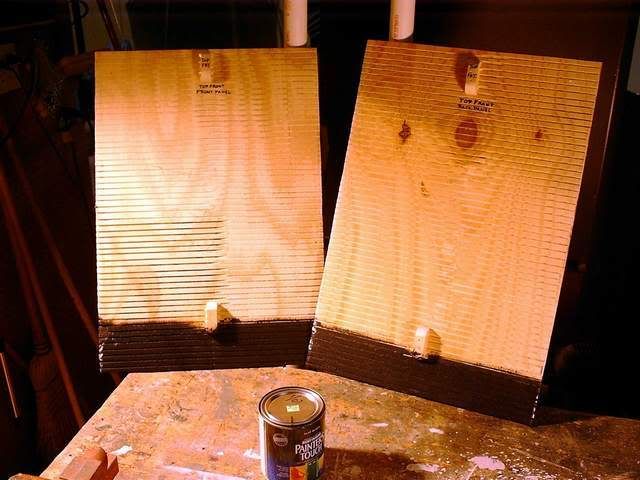
-
The small blocks attached to the panels are milled to a dimension and shape that allow them to not only slide along the adjacent panel during installation, but they will maintain the 7/8" gap between panels if there is any warping.
-
-
The panels are slipped into their respective tracks routed into the inside face of the side panels of the box. In this pic, they are slid about 1/2 way in.
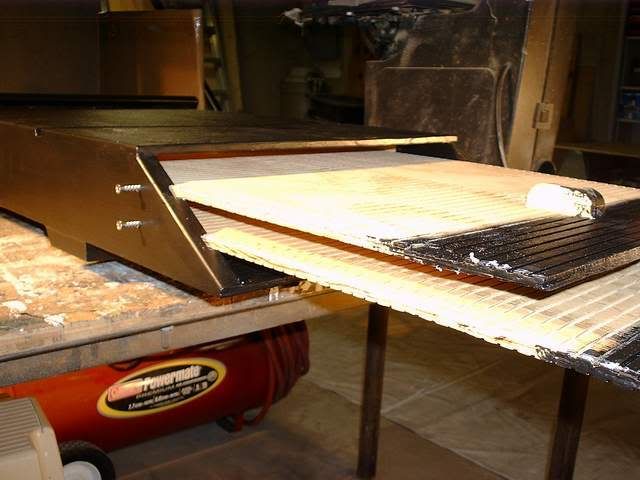
-
The SS screws will be buzzed in when the panels are completely inserted. They will pass thru the side panel, the center-line of the routed panel groove, and miss the panels just below them. These screws will provide support so the panels don't slide out AND a quick and easy way to remove the panels should the box or panels ever need maintanance.
-
-
The finished product
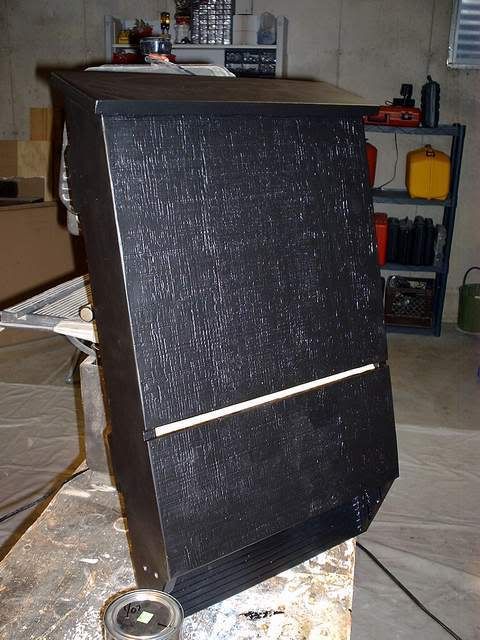
-
The permanent back panel of the house extends about 6" lower to provide a landing pad. The entire interior surface of the back panel and the front panel are also lightly grooved for bat-traction. In essence, there are a total 6 grooved panel surfaces creating 3 separate 7/8" compartments, providing a dry and cozy bat mosh-pit. The entire exterior is primed and finish coated with flat black latex. The 1/2" slot across the front panel is recommended to provide some heat control for this, the sun-facing compartment. I was concerned for blowing rain that might eventually compromise the unpainted interior, so I caulked and screwed on a drip cap over the vent crack.
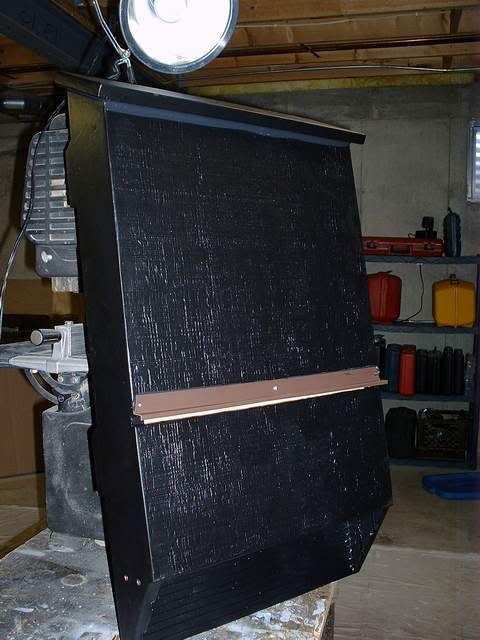
-
The mount is beefed up with a pair of 1" thick treated blocks, glued and screwed horizontally across the back of the house. A 3/8" SS tee-nut is embedded from within the box, thru the back panel; one at the top mount block and one at the bottom mount block. A pair of 3/8" SS hex bolts will crank 'er down to the bat pole.
-
-
The real issue is going to be mounting the unit. It has to be a min of 12' above the ground, or in my case, the water. Like the Wood Duck boxes, it is also kinda heavy (the WD boxes are alot lower, so no issue). I bought a length of 2" square tubing and cut it to length. It is primed and painted and the mounting holes are pre-drilled. I plan to bolt it to one of the unused 4 x 4 treated pole units that is embedded in concrete in about 2' of wetland water at normal pool. I fear, tho, that the box is gonna be like a kite when it gets windy. The stout treated 4 x 4 base may be overtaxed by the tall kite fulcrum; we'll see. Worse comes to worse, we can move it over to the building pad and use the rest of the 2" tubing, embedded in another concrete-filled post hole.
...my own quote, from pg 3
We have 8 poles totally installed. 4 of them have the completed WD boxes installed. I still have to design and install predator guards; fill ya in when we get there.
We're there.
I keep thinkin' I gotta be nuts. It's 15 degrees, the wind is honkin', and I'm going to spend quality time with my new predator guards. Donna-ski declined my generous offer to join me. Smart girl, me thinks.
So, I pre-fab'd the guards in the basement from panels of galvanized steel. I rolled up a blank into a tube and pop-riveted it together. The result is a ho-made galvanized stove pipe, 12" dia x 4 ft long. I also pre-fab'd the covers for the top. More galvanized sheet stuff. Essentially, a 12" dia blank with eight tabs around the circumference that will be bent downward and sheet metal screwed to the top of the tube. A 3-1/2" square hole is cut into the center of this cap blank to slip over the 4 x 4 treated pole.

-
I removed the top 1/2 of the pole assembly, splitting it at the hinge, and slipped the tube over the bottom pole section and slipped the tube-cap blank up onto the top section.

-
Then I re-assembled the pole and drilled/screwed on the tube-cap on-site. Eight sheet metal screws, one screw per tab on the tube-cap.
-
-
Next, a way to push the tube assembly up to the top of the pipe and keep it there. The 3-1/2" square hole in the tube-cap will keep the top centered and stabilized, but I had to come up with a quick and easy way to stablilize the bottom of the tube (to keep it from banging in the wind...ref: Davidson Blue bird scare mechanism) AND keep the tube up high on the pole.
-
Cake! About 12" up from the bottom of the tube I drilled 2 holes x 1/4" dia. They are 180 degrees apart (opposite each other) and perpendicular to the 4 x 4 support pole underneath. Thru each hole, I slipped in a 1/4" x 5" SS lag screw with a SS washer. I reached up underneath the tube with a pre-cut pc of 1/2" x 4" long PVC pipe spacer, slid the lag screw thru it, and screwed the lag into the 4 x 4. No drill; I just gave the lag screw a solid rap or two with a hammer to force-start them and a wratchet snugs 'em down. I'm hopin' 2 of these Lag-PVC spacer units will do it. It sure seemed stable.
A view looking directly up from inside the tube. The very top looks like daylight, but it is the camera flash reflection off of the interior side of the galvanized tube cap at the top; the sheet metal screws that hold the cap on are visible.
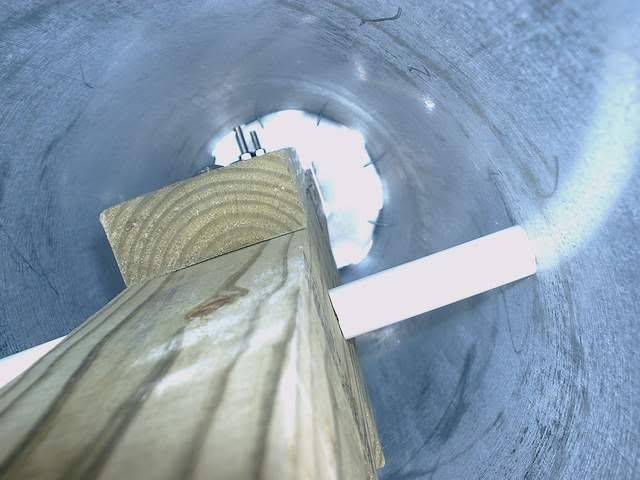
Brettski:
I've not had any coons shinny up either pole yet...however a squirrel managed to (many times, I suppose) jump that 5 foot gap from the hedge tree nearby...I'll have to give those branches a trimming. If he's still willing to jump down 8 feet and try to land on the roof of that box...it's all his.
Those braces are kinda U-shaped...maybe that's why coons have climbed up there, yet. It's also about 7 feet up to the box right now from dry land. It'll be in the water when (if?) the pond ever fills. :rolleyes:
...and a half dozen Peterson design cedar Bluebird houses.
-
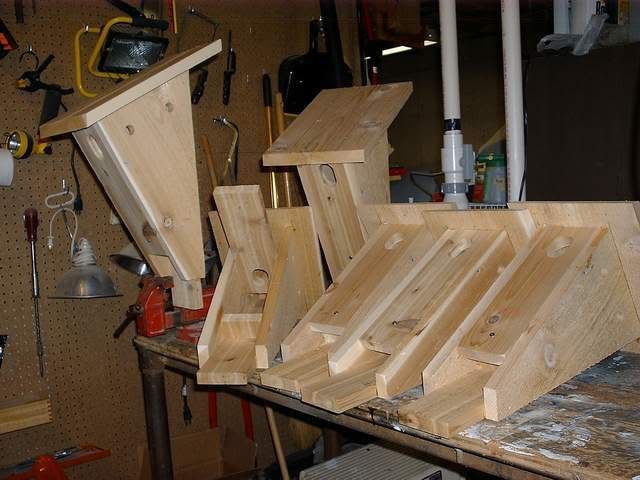
-
Yeah, I broke down and paid for the cedar. No regrets. After putting more time into priming and painting the WD boxes and the Bathouse than it took to build 'em, I decided to experiment with the right wood for the job. Polyurethane glue and galv finish nails outta the Porter Cable nail-gun...cake. Actually, I spent more time altering the construction details to eliminate use of 2 x 4 stock as a frame, building them entirely out of 1 x stock. The original plans are a stock pattern and design with field-tested performance. I swiped my copy from
the USGS website .
Next step is installation. I'm thinkin' about using 1" conduit with the same predator guard I used on the WD boxes. We'll see...a little time to think whilst I wait for the thaw.
...a little pond critter update.
-
-
D-ski and I have been installing bird housing like we have a government grant. I hope the prospective residents show up for the open house.
Last December, we installed the eight 4 x 4 posts for houses and nesting structure. Four of them were used for the wood duck nesting boxes. I originally planned to install the bat house on one post, but I have scrapped that installation plan for fear that the post will not be strong enough to support the structure (it will be installed in the building pad area a little later this spring). This leaves four unused posts in the soon-to-be wetland area.
Have ya ever heard of Mallard factories? I hadn't...'til now. I got the plans and inspiration from
the Delta Waterfowl website . Of course, their plan was just too dang crude and simple, so I bumped it a couple of notches. The basic nesting structure, tho, is to spec.
-
-
I cut a pc of old green treated 2 x 6 to 30" long and drilled a 1/2" hole in the center to lag it to the top of the 4 x 4 post in the pond. A couple of 1/4" holes were drilled at each end of this 2 x 6 to secure the 1/4" x 1.500" circular bar stock brackets I fab'd.
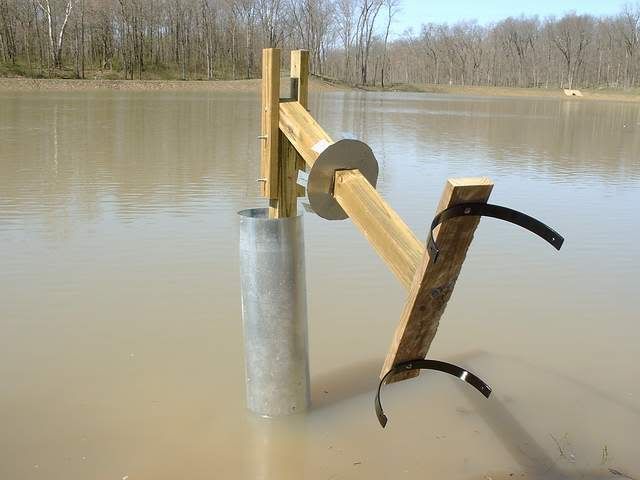
-
-
We pre-fab'd the actual nest tube in the garage at home. It is made out of one pc of galvanized hardware cloth, 1/2" squares, 36" wide x 7 feet long. See the website link above for details of construction. We are fortunate to have good friends in Jackie and Rebecca. They operate a fairly substantial farm around the corner and donated the straw and hay required to complete the nesting tubes. The tube is wired to the brackets securely with stainless steel wire.
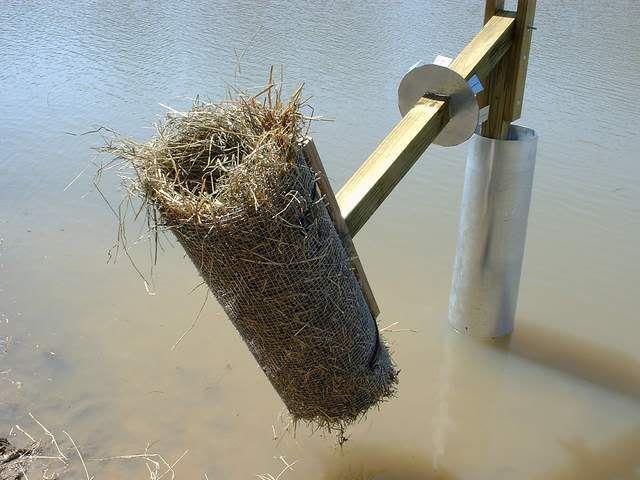
-
-
Flip up the hinged section and install the stainless bolt pin and tighten 'er up. A few sheet metal screws and a couple of stainless support lags and the predator guard is in place.
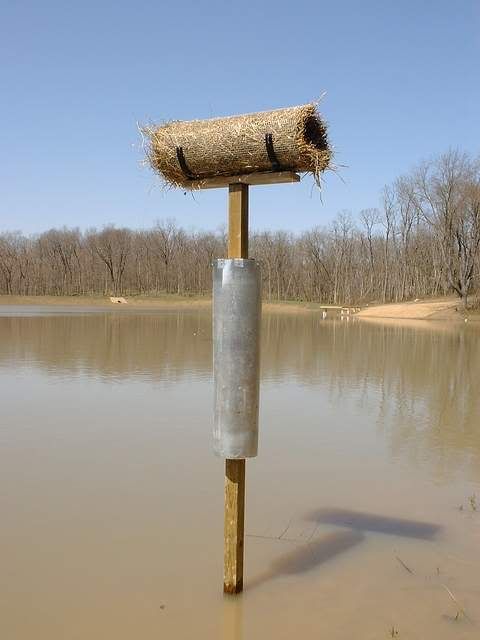
-
-
Two Mallard factories later...

-
-
The water level in the above pic has another 2-1/2 feet to go to get to normal pool. It will be just short of the bottom of the predator guards. I have to get back in there with the chain saw before it gets alot higher. There are a couple of scrubby trees that are too close to the nesting structures. HERE IS MY QUESTION: If the water is another 2-1/2 feet deep and runs well back into the woods, what critters do I fear leaping from the trees down to the nesting structures, then swimming back. Most of the trees are a a good 20 - 30 feet back. Do squirrels swim?
Most animals can swim if needed be..............
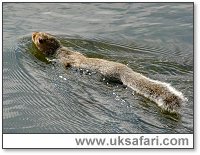
I was weed eating in the back yard about 20 feet from the back door and a Duck flew out of the tall weeds directly in front of my trimmer mower.
Turns out the morher has nested next to my baldcypress in the back yard. I left the tall weeds around the nest. I'm hoping my dogs don't discover it before they hatch. It's amazing what turns up when you live on a pond.
We're meeting with the pond builder tomorrow and I'm thinking about something similar to Brettski which I'll call plan C.
Plan A is a 4 acre pond with what I believe to be a fairly traditional contour.
Plan B at full pool would be something like 7 acres. The contractor previously expressed doubts about that choice. I think one reason is that much of the additional area would be fairly shallow, maybe less than 2 feet on average without substantial excavation. If we excavate this area to a deeper level then I believe we get into issues of water supply for this volume of water. Also this would probably be pretty costly.
Plan C, which is at this point only in MY head, is to build the dam at the higher level, but not to excavate the shallow area, and to leave many or all of the trees. Most of the shallows would be in the narrow portion of the pond where the main run-off enters it. It would roughly be a triangle about 150 feet on each bank and about the same distance across the pond.
In a normal weather pattern the shallows would be covered almost all year. With the current drought it would be dry. My understanding is that many types of trees can tolerate some minimal flooding for months at a time if they have alternating dry spells. There are tulip poplars, sweetgums, water oaks, and some pines. Many of these trees are constantly wet already, in absence of drought conditions. Since I can't count on future dry periods (hopefully), I was wondering about installing an alternate spillway for a lower pool level that would leave the shallows dry. That way if the rain was steady again I could open this other spillway and give the trees the dry period they need to survive.
I'm curious what effects raising and lowering the level once or twice a year would have on the banks that have been rimmed. Could this have some benefits? Also would what I've described make a useful habitat for land and pond creatures, one or both?
If this were my pond only I might wait and do more research, but this is Cindy's pond (and money) and she doesn't want to wait. My little pond will be more straight forward. I think.
Boy, I sure like that "C" plan.
I know that there are varying forum attitudes on the NRCS in Georgia, but maybe this is where alot of the answers lie. To me, as we are going to do, I'm letting it flood and if they die...they die. In fact, I expect that they will. My area, tho, is WAY smaller that 2 acres. You are now toying with creating a wetland, which is where you have to make a conscious decision if you plan on involving the NRCS. The downside is going higher profile with the guvmint; make very sure you know the stakes. The upside is that they should not only be able to help you with your vegetation questions, but creating a 2 ac wetland is what trips their trigger. You might be able to get funding to do it. BUT, you need to research and understand the ramifications of their involvement. I would check into it, doing my best to remain as anonymous and low on the radar as possible.
Thanks Brettski. I don't think working with the gubmint is in the cards for this one, but I recognize there are advantages. I don't think Cindy will have the patience to jump through all of the hoops though and it's her piece of the property.
Have you heard of anyone who designed two different levels of spillway?
I wish I knew more about fish behavior. Would there be an advantage to have a shallow area to flood for spawns or in certain weather, etc? Wish I had more time to research this too.

I have a similar situation that occurs naturally, with the shallow end rising and falling. The sweet gums will eventually take over, or worse, chinese tallow trees will establish. Also willows. They are near impossible to get rid of if established. Just be ready to monitor it closely and do necessary harvesting. I would leave the water level to nature and let establish what will live in the environment. As the silt builds up in later years, much flora will develop.
On second thought, maybe to be able to hold in more water will help keep some species under control.
check out Agridrain . Good folks, good products and service.
Brettski: Do you think I should copy/paste my posts in a new thread? I didn't mean to hijack your thread.
burger: In this part of Georgia there are normally no really dry periods. The average annual rainfall is almost 60 inches. If we get back to the regular weather pattern the pond level will stay relatively high, keeping the shallows flooded all year (with a properly constructed pond of course!). In that case I wouldn't get the variation in level that you describe. In fact, I'm a little concerned because I believe that normally the little branch that feeds the pond runs constantly. I haven't been here for a full year yet, but I was here to visit a few times before the drought and I think it was always moving.
So far I don't see either willows or chinese tallow. I'm thinking that if I could lower the pond level to expose the shallow area for several months at a time I could easily go in and clear out any undesirable trees. The sweetgums are already very common in the pond site with a few individuals that have 18 inch diameter trunks. The Water oaks are just as big and plentiful.
I'm curious what would happen if the pond was at the highest level and shoreline weeds became too thick. Could I lower the level and dry them out? On the other hand if the pond had been at the low level for several months with a similar weed problem, what would happen if the water level was increased by 2 or 3 feet?
Would it be practical to use two siphon spillways to create the two different levels? Could you just install a valve on the lower siphon and simply close it to raise to the higher level? I think I've read about people here using two siphons on one pond. Would that be typical on a pond this size? Would both siphons function properly if one was 2 feet lower than the other? I guess the higher siphon would have to be larger in case the lower siphon was closed and it had to handle the entire overflow.
Damn Yankee exercises admirable forum etiquette:
Brettski: Do you think I should copy/paste my posts in a new thread? I didn't mean to hijack your thread.
Very considerate, D-Y...almost funny when one considers all the threads I've crashed.

In the eyes of a forum purist, so long as the content is pertinent to the subject, it belongs. Most of my better threads (I still have one set of counting fingers available) are being compiled in the
"Chasing a Dream" chronology for those that follow. I think your contribution to wetland development discussion absolutely belongs.

Well thanks Brettski, I try to be a good neighbor...
We just finished meeting with the pond man and the winner is...........
PLAN C!

This contractor actually has experience with building dual level ponds. He's done it for people who wanted to attract duck for hunting purposes. They leave large trees flooded for up to 4 months before draining down to the lower pool level.
Okay, I'll wait till I'm fishing to celebrate.
For this pond (Cindy's), the contractor ask if he could create some "reefs" with the removed stumps. Any thoughts?
That sounds really great...except, how does he plan on ensuring they don't float around? I've got an entire giant cottonwood that's been floating for more than three years. I've got it tied in place now, but it just doesn't want to sink.
Perhaps the root balls themselves won't float...but I'd still ask. That would be awesome structure. She might get kinda tired of looking at them, until they get submerged...just a heads up, from my wifey's experience.
Cindy was at the meeting and was all for it. She already knows that I'm considering tractor tires and maybe palates and she's fine with those.
Overall she's pretty cool for a female.
Well, finally got a chance to install 6 Peterson design Bluebird houses. I was holding back until all the areas designated for seeding with native grasses and wildflowers was completed; didn't want to get in the way of my farm-pal, his tractor, and the seed drill. Anyway, it's all done.
Bluebird houses are best installed away from timber and away from each other. As it winds up, I only built 6 of them and based on the amount of open space we have within the parcel, 6 is about all I need. 2 went in the 2 ac meadow, 2 at the driveway entrance meadow, and 2 at the pond (one on the dam and one on the bldg site). I'm gonna throw out a couple more boring details for those that may interested in the installation; whoever you are, please wake up. Actually, I want to share the construction of the predator guard baffle. Installation without one is foolish and an invitation to bird-disaster.
-
-
Pounded in a 3/4" dia x 36" rebar. This fits very snug inside the I.D. of the 3/4" EMT electrical conduit we used as the support pole. I took a block of 3/4" thick cedar x 4" square, poked a 7/8" hole in the center, and dropped it over the rebar (just before slipping on the pipe) to keep the conduit pole from slipping downward into the soil, thus shortening the height of the entire structure.
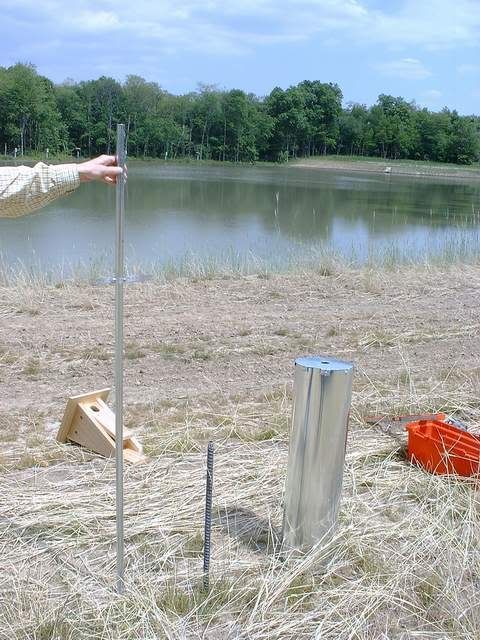
I have been doing my Condello stretching exercises religiously, hence my ability to not only take the photo, but hold up the pipe for reference.
-
The predator guard is an 8" galv stove pipe x 30" long. I had some galv sheet and cut the tops with snips and screwed it on (very similar to the wood duck box guards earlier in this thread). A 1-1/8" hole is drilled thru the center of the galv cap (or big enough to slip over the pole loosely). The pole is 60" long, pre-drilled at home to match up with holes in the cedar bird houses.
-
The predator guard (or baffle) simply slips over the top of the pole and rests on a bracket made out of galv pipe strap.
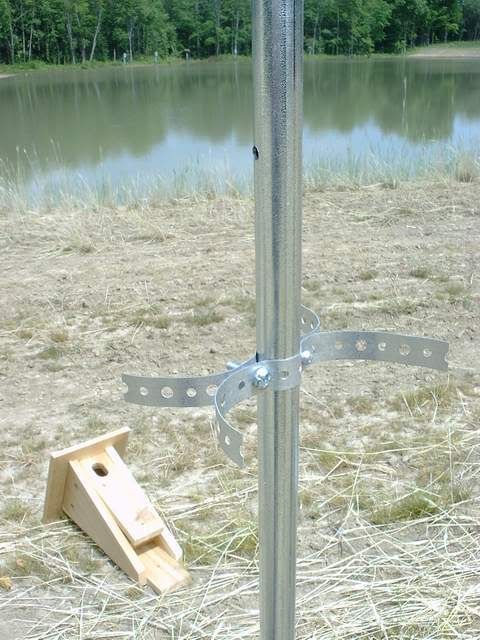
This strap configuration keeps the baffle supported and allows it to rock as coons try to get a bear hug on it. I am uncertain how the "bumping in the wind" will be received by any prospective tenant.
-
The birdhouse attaches with 2 pc 1/4" x 2-1/2" stainless steel carriage bolts and hardware.
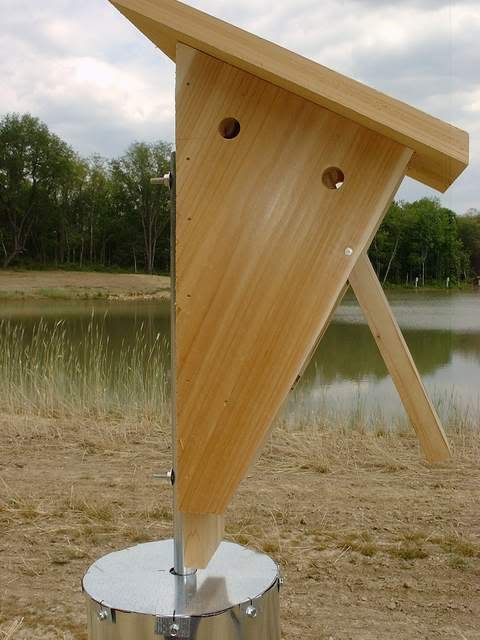
-
Close up the access cover with a screw and turn on the
Vacancy sign.
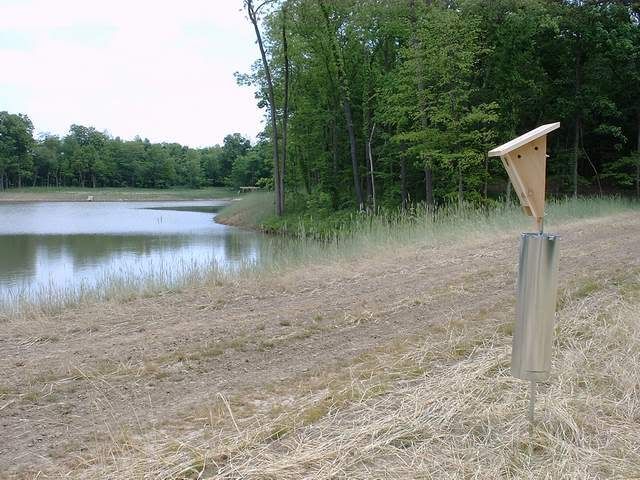
-
(NOTE: 2 hours after they were installed, about a dozen Tree Swallows were taking turns checking them out and fighting over who was going in next)
An update on the bird housing....
The wood duck houses and the mallard nesting tubes show no signs of apparent activity. The smaller chickadee houses dispersed in the woods are mostly vacant, but a couple have wrens living in them (wonderful, easily identified song). The Peterson bluebird houses, tho, are NO VACANCY. Unbelieveable response. We put up six, well spaced and away from the timberline (per spec for attracting bluebirds). 3 have Tree Swallows and 3 have bluebirds. I know that so much of attracting birds is the species and the region, but from my 'hood, these cedar Peterson BB houses are the hot ticket.
an update to a REAL old project that never got completed....
-
about 6 years ago, as part of building a buncha bird houses, I also put together a bat house. As goes many of my projects, I came outta the gate like a race horse, but about the 3rd turn, I got distracted and never finished the race. The bat house has been in storage ever since....until now.
-
It all started here back in 2007. -
...and winds up here, some 6+ years later. Inspired by Loretta's post:
...I bought a mesh tray that's made for organizing silverware and mounted two snall 90 degree brackets about 18" beneath the bat house on the eave....Bat babies often fall out of the house and the tray catches them and allows them to crawl back into their house....
I added the bat baby catcher to the bottom of the house and provided a trellis of hardware cloth to allow ascension back into the cozy bat abode above.
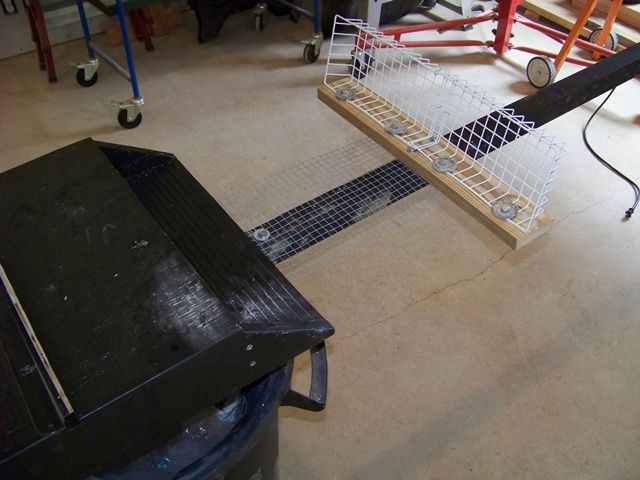
And, finally, the 2" tubing pole is set into concrete and the new bat digs are displaying a
vacancy sign.
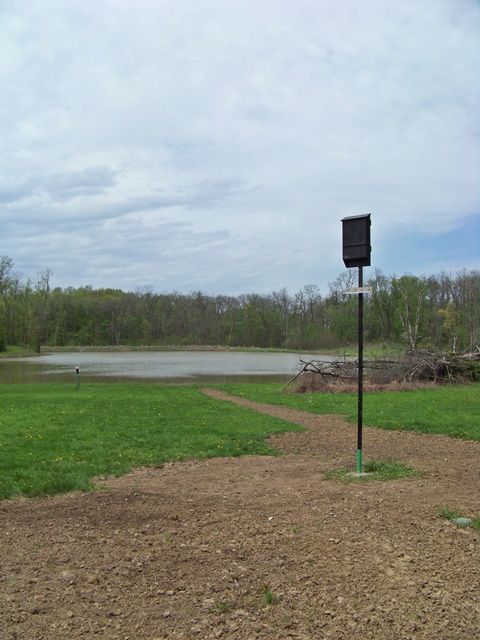
I like the baby catcher. I built one about 5 years ago. No bats yet.
Any idea why Dave?
My wife really wants a number of them (2-4) on our 30 acre hay field but the project will get pushed off if we arent going to see any results...
I don't know. I put in an old barn with no results. I occasionally see bats but not many. Of course, it might just be my house building skills.
It could also be the disease going around killing bats that hibernate in caves. Drastic reductions here in Upstate NY. I have two bat houses up under the eaves of the house for three years running, and no takers. I do see a few flying about, but not like it was 5 years ago.
Location really matters for bat houses. If you don't have bats after 5 years, you should consider moving the house. Generally speaking, they like heat.
This site has good info:
http://www.batmanagement.com/Batcentral/batboxes/choosingsite.htmlIt says that in southern locations, mount the houses outside, on a pole, back to back. That way when one side gets too hot, they can move to the other side.
When I had bats in the loft of my barn, they'd move from the East side to the West side depending on where the sun was.
I face my bat houses south. Initially it took a couple of years to get returning residents.
Nice looking set up Brettski!































